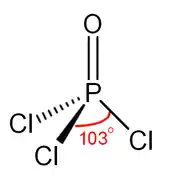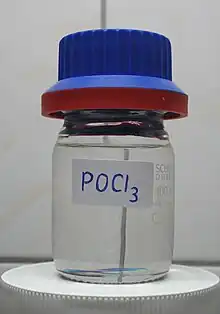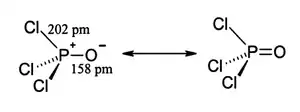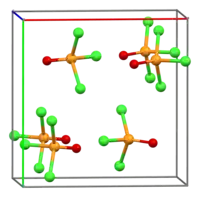Phosphoryl chloride
Phosphoryl chloride (commonly called phosphorus oxychloride) is a colourless liquid with the formula POCl3. It hydrolyses in moist air releasing phosphoric acid and fumes of hydrogen chloride. It is manufactured industrially on a large scale from phosphorus trichloride and oxygen or phosphorus pentoxide.[4] It is mainly used to make phosphate esters such as tricresyl phosphate.
 | |||
| |||
 | |||
| Names | |||
|---|---|---|---|
| Preferred IUPAC name
Phosphoryl trichloride[1] | |||
Other names
| |||
| Identifiers | |||
3D model (JSmol) |
|||
| ChEBI | |||
| ChemSpider | |||
| ECHA InfoCard | 100.030.030 | ||
| EC Number |
| ||
| 2272 | |||
PubChem CID |
|||
| RTECS number |
| ||
| UNII | |||
| UN number | 1810 | ||
CompTox Dashboard (EPA) |
|||
| |||
| |||
| Properties | |||
| POCl3 | |||
| Molar mass | 153.32 g·mol−1 | ||
| Appearance | colourless liquid, fumes in moist air | ||
| Odor | pungent and musty | ||
| Density | 1.645 g/cm3, liquid | ||
| Melting point | 1.25 °C (34.25 °F; 274.40 K) | ||
| Boiling point | 105.8 °C (222.4 °F; 378.9 K) | ||
| Reacts | |||
| Solubility | highly soluble in benzene, chloroform, carbon disulfide, carbon tetrachloride | ||
| Vapor pressure | 40 mmHg (27 °C)[2] | ||
Refractive index (nD) |
1.460 | ||
| Structure | |||
| Tetrahedral at the P atom | |||
| 2.54 D | |||
| Thermochemistry[3] | |||
Heat capacity (C) |
138.8 J·mol−1·K−1 (liquid), 84.9 J·mol−1·K−1 (gas) | ||
Std molar entropy (S⦵298) |
222.5 J·mol−1·K−1 (liquid), 325.5 J·mol−1·K−1 (gas) | ||
Std enthalpy of formation (ΔfH⦵298) |
−597.1 kJ·mol−1 (liquid), −558.5 kJ·mol−1 (gas) | ||
Gibbs free energy (ΔfG⦵) |
−520.8 kJ·mol−1 (liquid), −512.9 kJ·mol−1(gas) | ||
Enthalpy of fusion (ΔfH⦵fus) |
13.1 kJ·mol−1 | ||
Enthalpy of vaporization (ΔfHvap) |
38.6 kJ·mol−1 | ||
| Hazards | |||
| Occupational safety and health (OHS/OSH): | |||
Main hazards |
Toxic and corrosive; releases HCl on contact with water[2] | ||
| GHS labelling: | |||
    | |||
| Danger | |||
| H302, H314, H330, H372 | |||
| P260, P264, P270, P271, P280, P284, P301+P312, P301+P330+P331, P303+P361+P353, P304+P340, P305+P351+P338, P310, P314, P320, P321, P330, P363, P403+P233, P405, P501 | |||
| NFPA 704 (fire diamond) | |||
| Lethal dose or concentration (LD, LC): | |||
LD50 (median dose) |
380 mg/kg (rat, oral) | ||
| NIOSH (US health exposure limits): | |||
PEL (Permissible) |
none[2] | ||
REL (Recommended) |
TWA 0.1 ppm (0.6 mg/m3) ST 0.5 ppm (3 mg/m3)[2] | ||
IDLH (Immediate danger) |
N.D.[2] | ||
| Safety data sheet (SDS) | ICSC 0190 | ||
| Related compounds | |||
Related compounds |
|||
| Supplementary data page | |||
| Phosphoryl chloride (data page) | |||
Except where otherwise noted, data are given for materials in their standard state (at 25 °C [77 °F], 100 kPa).
Infobox references | |||
Structure
Like phosphate, POCl3 is tetrahedral in shape.[6] It features three P−Cl bonds and one strong P–O bond, with an estimated bond dissociation energy of 533.5 kJ/mol. Unlike in the case of POF3, the Schomaker-Stevenson rule predicts appropriate bond length for the P–O bond only if the P–O bond is treated as a double bond, P=O. More modern treatments explain the tight P–O bond as a combination of lone pair transfer from the phosphorus to the oxygen atom and a dative π back-bond that produces an effective [P+]-[O-] configuration.[7]

Phosphoryl chloride exists as neutral POCl3 molecules in the solid, liquid and gas states. This is unlike phosphorus pentachloride which exists as neutral PCl5 molecules in the gas and liquid states but adopts the ionic form [PCl4]+[PCl6]− (tetrachlorophosphonium hexachlorophosphate(V)) in the solid state. The average bond lengths in the crystal structure of POCl3 are 1.98 Å for P–Cl and 1.46 Å for P=O.[5]
Physical properties
It has a critical pressure of 3.4 atm.[8] With a freezing point of 1 °C and boiling point of 106 °C, the liquid range of POCl3 is rather similar to water. Also like water, POCl3 autoionizes, owing to the reversible formation of [POCl2]+ cations (dichlorooxophosphonium cations) and Cl− anions.
Chemical properties
POCl3 reacts with water to give hydrogen chloride and phosphoric acid:
- O=PCl3 + 3 H2O → O=P(OH)3 + 3 HCl
Intermediates in the conversion have been isolated, including pyrophosphoryl chloride, O(−P(=O)Cl2)2.[9]
Upon treatment with excess alcohols and phenols, POCl3 gives phosphate esters:
- O=PCl3 + 3 ROH → O=P(OR)3 + 3 HCl
Such reactions are often performed in the presence of an HCl acceptor such as pyridine or an amine.
POCl3 can also act as a Lewis base, forming adducts with a variety of Lewis acids such as titanium tetrachloride:
- POCl3 + TiCl4 → POCl3·TiCl4
The aluminium chloride adduct (POCl3·AlCl3) is quite stable, and so POCl3 can be used to remove AlCl3 from reaction mixtures, for example at the end of a Friedel-Crafts reaction.
POCl3 reacts with hydrogen bromide in the presence of Lewis-acidic catalysts to produce POBr3.
Preparation
Phosphoryl chloride can be prepared by many methods. Phosphoryl chloride was first reported in 1847 by the French chemist Adolphe Wurtz by reacting phosphorus pentachloride with water.[10]
By oxidation
The commercial method involves oxidation of phosphorus trichloride with oxygen:[11]
- 2 PCl3 + O2 → 2 POCl3
An alternative method involves the oxidation of phosphorus trichloride with potassium chlorate:[12]
- 3 PCl3 + KClO3 → 3 POCl3 + KCl
Oxygenations
The reaction of phosphorus pentachloride (PCl5) with phosphorus pentoxide (P4O10).
- 6 PCl5 + P4O10 → 10 POCl3
The reaction can be simplified by chlorinating a mixture of PCl3 and P4O10, generating the PCl5 in situ. The reaction of phosphorus pentachloride with boric acid or oxalic acid:[12]
Other methods
Reduction of tricalcium phosphate with carbon in the presence of chlorine gas:[13]
The reaction of phosphorus pentoxide with sodium chloride is also reported:[13]
- 2 P2O5 + 3 NaCl → 3 NaPO3 + POCl3
Uses
In one commercial application, phosphoryl chloride is used in the manufacture of phosphate esters. Triarylphosphates such as triphenyl phosphate and tricresyl phosphate are used as flame retardants and plasticisers for PVC. Trialkylphosphates such as tributyl phosphate are used as liquid–liquid extraction solvents in nuclear reprocessing and elsewhere.[11]
In the semiconductor industry, POCl3 is used as a safe liquid phosphorus source in diffusion processes. The phosphorus acts as a dopant used to create n-type layers on a silicon wafer.
As a reagent
In the laboratory, POCl3 is a reagent in dehydrations. One example involves conversion of formamides to isonitriles (isocyanides);[14] primary amides to nitriles:[15]
- RC(O)NH2 + POCl3 → RCN + PO2Cl + 2 HCl
In a related reaction, certain aryl-substituted amides can be cyclized using the Bischler-Napieralski reaction.
Such reactions are believed to proceed via an imidoyl chloride. In certain cases, the imidoyl chloride is the final product. For example, pyridones and pyrimidones can be converted to chloro- derivatives such as 2-chloropyridines and 2-chloropyrimidines, which are intermediates in the pharmaceutical industry.[16]
In the Vilsmeier-Haack reaction, POCl3 reacts with amides to produce a "Vilsmeier reagent", a chloro-iminium salt, which subsequently reacts with electron-rich aromatic compounds to produce aromatic aldehydes upon aqueous work-up.[17]
References
- Nomenclature of Organic Chemistry: IUPAC Recommendations and Preferred Names 2013 (Blue Book). Cambridge: The Royal Society of Chemistry. 2014. p. 926. doi:10.1039/9781849733069-FP001. ISBN 978-0-85404-182-4.
- NIOSH Pocket Guide to Chemical Hazards. "#0508". National Institute for Occupational Safety and Health (NIOSH).
- CRC handbook of chemistry and physics : a ready-reference book of chemical and physical data. William M. Haynes, David R. Lide, Thomas J. Bruno (2016-2017, 97th ed.). Boca Raton, Florida. 2016. ISBN 978-1-4987-5428-6. OCLC 930681942.
{{cite book}}: CS1 maint: location missing publisher (link) CS1 maint: others (link) - Toy, Arthur D. F. (1973). The Chemistry of Phosphorus. Oxford: Pergamon Press. ISBN 978-0-08-018780-8. OCLC 152398514.
- Olie, K. (1971). "The crystal structure of POCl3". Acta Crystallogr. B. 27 (7): 1459–1460. doi:10.1107/S0567740871004138.
- Greenwood, N. N.; Earnshaw, A. (1997). Chemistry of the Elements (2nd ed.). Oxford: Butterworth-Heinemann.
- Chesnut, D. B.; Savin, A. (1999). "The Electron Localization Function (ELF) Description of the PO Bond in Phosphine Oxide". Journal of the American Chemical Society. 121 (10): 2335–2336. doi:10.1021/ja984314m. ISSN 0002-7863.
- https://www.stenutz.eu/chem/solv6.php?name=phosphoryl+chloride
- Grunze, Herbert (1963). "Über die Hydratationsprodukte des Phosphoroxychlorides. III. Darstellung von Pyrophosphorylchlorid aus partiell hydrolysiertem Phosphoroxychlorid (Hydration products of phosphorus oxychloride. III. Preparation of pyrophosphoryl chloride from partially hydrolyzed phosphorus oxychloride)". Zeitschrift für Anorganische und Allgemeine Chemie. 324: 1–14. doi:10.1002/zaac.19633240102.
- Wurtz, Adolphe (1847). "Sur l'acide sulfophosphorique et le chloroxyde de phosphore" [On monothiophosphoric acid and phosphoryl chloride]. Annales de Chimie et de Physique. 3rd series (in French). 20: 472–481.; see Chloroxyde de phosphore, pp. 477–481. (Note: Wurtz's empirical formulas are wrong because, like many chemists of his day, he used the wrong atomic mass for oxygen.)Roscoe, Henry Enfield; Schorlemmer, Carl; Cannell, John, eds. (1920). A Treatise on Chemistry. Vol. 1 (5th ed.). London, England: Macmillan and Co. p. 676.
- Bettermann, Gerhard; Krause, Werner; Riess, Gerhard; Hofmann, Thomas (2000). "Phosphorus Compounds, Inorganic". Ullmann's Encyclopedia of Industrial Chemistry. Weinheim: Wiley-VCH. doi:10.1002/14356007.a19_527..
- Pradyot, Patnaik (2003). Handbook of Inorganic Chemicals. New York: McGraw-Hill. p. 709. ISBN 0-07-049439-8.
- Lerner, Leonid (2011). Small-Scale Synthesis of Laboratory Reagents with Reaction Modeling. Boca Raton, Florida: CRC Press. pp. 169–177. ISBN 978-1-4398-1312-6.
- Patil, Pravin; Ahmadian-Moghaddam, Maryam; Dömling, Alexander (29 September 2020). "Isocyanide 2.0". Green Chemistry. 22 (20): 6902–6911. doi:10.1039/D0GC02722G.
- March, J. (1992). Advanced Organic Chemistry (4th ed.). New York, NY: Wiley. p. 723. ISBN 978-0-471-60180-7.
- Elderfield, R. C. (ed.). Heterocyclic Compound. Vol. 6. New York, NY: John Wiley & Sons. p. 265.
- Hurd, Charles D.; Webb, Carl N. (1925). "p-Dimethylaminobenzophenone". Organic Syntheses. 7: 24. doi:10.15227/orgsyn.007.0024.
Further reading
- Handbook of Chemistry and Physics (71st ed.). Ann Arbor, MI: CRC Press. 1990.
- Stecher, Paul G. (1960). The Merck Index of Chemicals and Drugs (7th ed.). Rahway: Merck & Co. OCLC 3653550.
- Wade, L. G., Jr (2005). Organic Chemistry (6th ed.). Upper Saddle River, NJ: Pearson/Prentice Hall. p. 477.
{{cite book}}: CS1 maint: multiple names: authors list (link) - Walker, B. J. (1972). Organophosphorus Chemistry. Harmondsworth: Penguin. pp. 101–116.
- "CDC – NIOSH Pocket Guide to Chemical Hazards".




